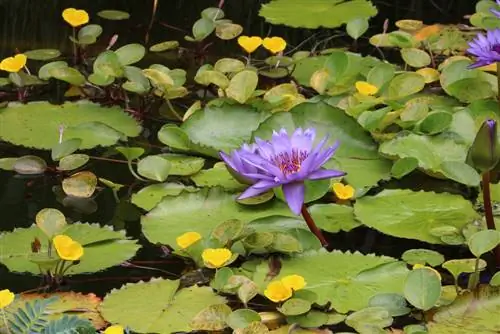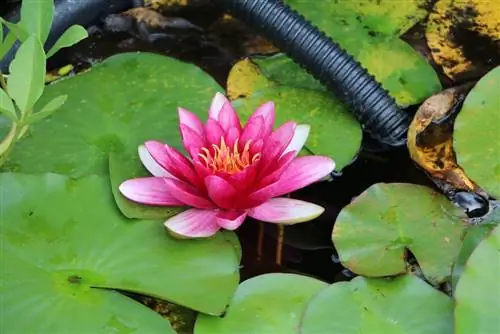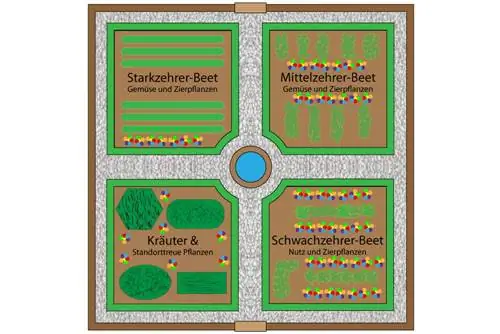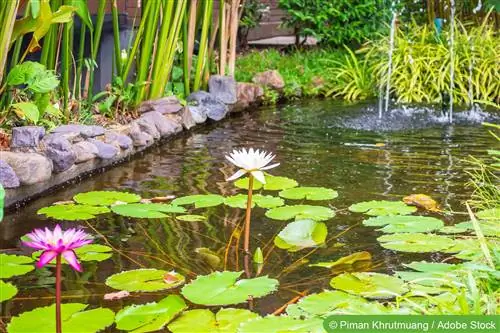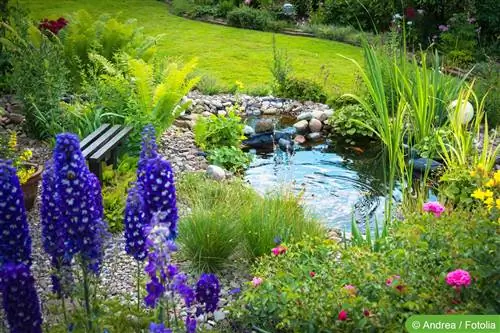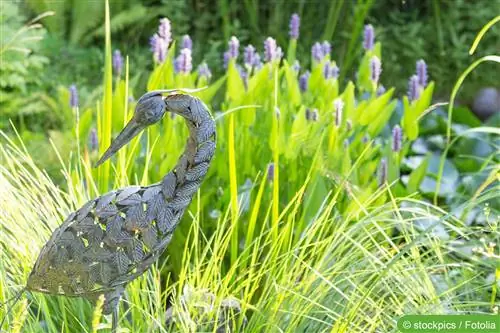The rule of thumb is not to use more than 5 plants per square meter. The smaller the pond, the fewer plants should be used. In small areas, a jumble of plants looks less good than the same number of the same plants. Underwater floating plants such as waterweed, milfoil, hornleaf, water feather and others are important for good water quality. They absorb excess nutrients from the water and release oxygen into the water. Plants cannot survive without oxygen. No mini pond can do without these plants. If possible, there should always be an underwater plant included, even with solitary plants.
Single water lily
There are special water lilies that do not require a great depth or an oversized container. Although a depth of 50 cm is ideal, for some even 20 cm is enough. Round vessels look a little better than square ones, but that's ultimately a matter of taste. The root of the water lily must be weighed down with stones, gravel or something similar, otherwise it will float up to the surface of the water. Suitable water lilies:
- Dwarf water lily (Nymphaea candida) - flower diameter 8 to 10 cm, flowering from June to August, water depth 25 to 50 cm (up to 80 cm), dark green round leaves (diameter 20 cm), white flowers, can be planted from May, press fertilizer kneaded in clay balls into the soil of the baskets in spring, hardy, quite easy to grow
- Water lily (Nymphaea x pygmaea 'Helvola') - small yellow flowers, only 2.5 cm in diameter, bloom from June to September, water depth 20 to 25 cm, not hardy, leaves dark green, can have red to reddish-brown stripes or spots, fertilize in spring (as just described) ideal for containers, great with blue-flowering perennials on the edge
- Water Lily (Nymphaea x laydekeri (varieties) - flowers pink (light purple pink darker on the inside or strong dark red with white markings, depending on the variety), up to 10 cm in diameter, flower June to September, water depth 25 to 30 cm, plants from mid-May, slow-growing, fertilize as described above, very willing to flower, ideal for pots
- Square water lily (Nymphaea tetragona) - small flowers, only 2.5 cm in diameter, pure white and fragrant, blooms from June to September, water depth 10 to 25 cm, can be planted Mid-May, the most delicate water lily, even grows in shallow bowls, then do not overwinter outdoors (commonly sold in stores under the name: Nymphaea x pygmaea 'Alba')
Water crowfoot in a glass vessel
Water buttercup is an underwater plant, but forms long shoots that float on the surface of the water. Finely tufted, long underwater leaves can be found under water, while kidney-shaped floating leaves float above water. Between June and September, numerous delicate buttercup flowers appear in white with a yellow center. They seem to float above the water level. Water crowfoot forms runners and the roots can also divide. The plant soon forms a dense carpet of plants in a container. With a glass container you can observe the plant above and below water. Of course, an opaque container is sufficient, because the nicer part grows above the water.
Swamp calla as a solitaire
The swamp calla is a beautiful flowering plant that, as the name suggests, prefers swampy areas. The plants grow to a height of 15 to 20 cm and are just as wide. The white flowers appear between June and July and last a long time if placed in the right location. The ideal depth is 20 cm. The swamp calla does not need an extra planter. It is enough to simply place the rhizome on the substrate in the container and weigh it down a little, for example with river pebbles or gravel. For the winter it is beneficial to store the rhizome frost-free. You have to remember that the plants are poisonous. This also applies to the beautiful berries that form after flowering. If you choose the marsh calla as a border plant, you can of course also add floating plants.
Water hyacinth as a solitaire
Water hyacinths are very decorative plants. The fleshy, bright green leaves and the bubble-shaped petioles are striking, but the highlight here are the flowers. The steel blue to light purple inflorescences are reminiscent of spring hyacinths. The plants don't always bloom. In addition to a lot of warmth and sun, they also need high humidity, which is why a gargoyle or fountain in the container makes sense. Water hyacinths are tropical plants. They need to be kept warm over the winter, preferably in a warm water aquarium. Overwintering is not easy, which is why many lovers of the plant buy them again and again in the spring.
Mixed planting of dwarf cattails, swamp forget-me-nots and water nuts
Dwarf cattails look like the large representatives of this species, only they are much smaller. They only grow to a height of 30 to 50 cm and belong in a water depth of 10 to 20 cm. These plants are ideal as border plants. To limit propagation, the dwarf cattail should be placed in a plant basket, otherwise its rhizome will quickly spread throughout the entire container and other plants will no longer have a chance. The swamp forget-me-not grows up to 30 cm high and blooms sky blue from May to September. The plants are ideal for the swamp zone. The planting depth is 0 to 10 cm.
Swamp forget-me-nots are well hardy and extremely robust. They multiply profusely, which is why they are best placed in a plant basket. This way the spread can be limited. In summer, the water nut forms a rosette of diamond-shaped floating leaves, which float on the surface of the water on reddish petioles. Towards the end of summer the leaves turn red and die. The nut-like stone fruits sink to the ground and sprout again in spring.
Cyprus grass, water iris and water lettuce (shell flower)
Cyprus grass actually works very well as a solitary plant, but is also suitable for background planting in a container. Cyprus grass grows from a rhizome. If you want to multiply it, you can simply divide it. To prevent uncontrolled spread, the rhizome should be placed in a planting basket. Flowering lasts from July to September. Cyprus grass is not hardy, but can easily be overwintered indoors. It is important to maintain high humidity levels. The water lily is a very noble aquatic plant. There are many types and varieties, so you can choose from almost all flower colors.
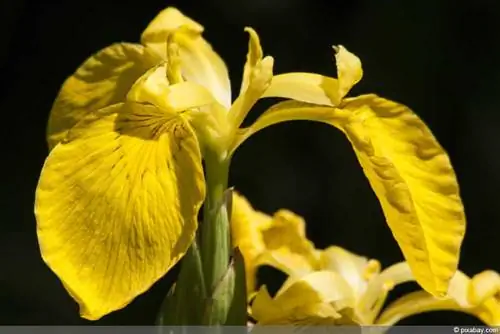
These irises like the swamp zone, but can also cope with the shallow water zone. You should only use one plant so that the flowers don't steal the show from the Cyprus grass. In addition, a lower variety should be chosen so that plants of different heights populate the container. Water lettuce looks very similar to lettuce, except that the plant floats on water and the leaves are slightly thicker. This plant absorbs a lot of nutrients from the water and thus prevents excessive algae growth. The plants form offshoots and multiply quite quickly. To contain them, it is enough to remove a few plants from the water every now and then. Water lettuce is quite sensitive to frost and must be overwintered at 15 to 20°C.
Frogbite
Froschbite works as a solitary plant, but also in association with other plants. It is a floating leaf plant, similar to the water lily. The plants prefer a slightly muddy water base in which the roots can anchor themselves. The rosettes float on the surface of the water. The flowers appear in midsummer and always consist of three petals and a bract. They are white with a yellow base. In autumn, winter buds form, which detach from the plant and sink to the bottom. New plants develop from them from April onwards. A location protected from the wind and warm water are important for frog bites. If you only plant frogbit, the entire water surface will soon become overgrown. This looks very nice. In between, floating candles, glass floating balls or similar decorative materials can develop their effect. A small fountain would also be conceivable.
Heart-leaved pikeweed, water poppy and swan flower (water violet, flower rush)
The combination of these three plants is ideal for containers that are not too small and too shallow. The heart-shaped pike herb looks good as a background plant or in the middle of a free-standing container. The plant grows upright and can reach a height of up to 60 cm, but also requires a water depth of 30 to 60 cm. Muddy soil is ideal. The flowering period extends from June to September. The inflorescences are quite large, the individual flowers are blue. The heart-shaped pike herb is not completely hardy and should be lowered to at least 50 cm in winter. The mini pond should not freeze. The water poppy is a floating leaf plant. The yellow flowers are only open for a short time, but new ones keep forming. The flowering period is from April to September.
Young plants form on the flower shoots, so that this plant can soon cover the water surface. It's best to remove some plants every now and then. Warm water is important for these plants. They like the shallow water zone because that is where the water warms up fastest and most. Water poppies are not hardy. It is best to plant it in a plant basket as it can be easily removed in the fall. Overwinter at 10 to 12 degrees. The swan flower belongs in the background because it grows quite tall. It can reach a height of 50 to 120 cm and grows upright. Their white to pink flowers, which also smell of honey, are particularly interesting. The flowering period is from June to August. The ideal water depth is between 10 and 30 cm. The best way to plant the swan flower is in a plant basket. It needs plenty of sun and lots of nutrients.
Horsetail
Horsetail is a fascinating plant. It looks great as a solitaire, but can also be kept together. The effect is achieved through the leaves, the bark and the narrow, upright growth. The plants like moist soil and partial shade to shade, so they are ideal for locations that are not too sunny. Horsetail can grow up to 150 cm high, although this takes a few years. The plants form runners and spread. This plant is planted to a water depth of 10 cm. Horsetail does not work in vessels that are too small. If you don't have space for a larger tank, you can use the dwarf horsetail as an alternative. This only reaches heights of around 20 cm and tolerates sun better, but not bright midday sun. Horsetail is frost hardy and can survive cold winters. In order not to weaken its effect, only slightly more inconspicuous plants should be planted together with it, for example water poppy, water nut, pennywort, swimming fern or frog bite.
Artificial decoration
If you don't want live plants in your mini pond, there are other ways to create a beautiful arrangement. A shallow bowl is best. The floor can be covered with beautiful light stones or shells. One or more floating candles on the surface of the water are usually enough to achieve an effect. There are floating candles in the shape of flowers that are good for this, ideally water lily candles of course. Alternatively, floating glass containers can be used in which a tea light is placed. Small glass figures provide highlights and variety. Nothing more is needed.
Conclusion
Planting a mini pond is not difficult at all. It is important to choose the right plants. They should fit together visually and in terms of their requirements. The right planting height is crucial for thriving. Some plants like deep water, others shallow or even swampy. If you don't take this into account, you won't be able to enjoy your mini pond for long.

